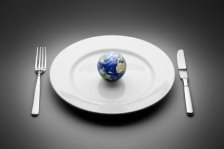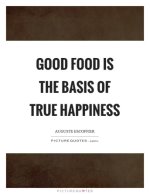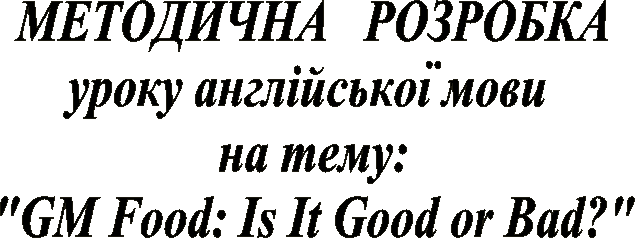Урок "GM food: is it good or bad?"
Конспект уроку англійської мови (11 клас). Тема за підручником: Nature and the Environment
Lesson #
Group _________ Date _________
GM food: is it good or bad?

Мета:
- актуалізувати відомості з тем “It’s Your Planet” “Eating Out”; розширювати межі володіння активними ЛО через різні види мовленнєвої діяльності: читання, аудіювання, усне і писемне мовлення;
- удосконалювати навички безперекладного розуміння коротких текстів, узагальнення значимої інформації; розвивати логічне мислення, творчу уяву; розвивати уміння аналізувати інформацію, визначати переваги і недоліки, формулювати і аргументувати свій вибір, сприяти формуванню уявлення про перспективи прийнятого рішення;
- виховувати чуття мови, зосередженість у нових мовленнєвих умовах, вміння самостійно розв’язувати поставлені комунікативні завдання; сприяти вихованню розуміння учнями важливості і необхідності відповідального ставлення до власного здоров’я, як запоруки благополуччя майбутніх поколінь суспільства.
Тип уроку: комбінований.
Обладнання: комп’ютер, проектор, мультимедійна дошка, презентація, роздавальний матеріал, підручник, зошит, словники
ХІД УРОКУ
І. INTRODUCTION.
Підготовка до сприйняття іншомовного мовлення.
1. Організаційна частина уроку (привітання, оголошення теми та мети уроку)
T.: Good morning, everybody! Glad to see you here. Welcome to our English lesson. Pupils, please, check if you have your text-books, copy-books, handouts and pens on you desks. Anton, what date is it today? (Учень відповідає) Open your copy-books and write down today's date, class work.
1. Warming-Up.
We have been discussing global problems for several lessons already as the theme of the program is “It’s Your Planet”. I expect you know much about the threats our Earth is facing nowadays. What can kill our planet? You can answer all together.
Учні називають загрози життю на Землі.
Natural disasters Man-made disasters Asteroids Terrorism Technological advances
Вправа на поєднання.
T.: Look at these newspaper headlines and define the dangers.





2. Revision. Checking homework.
At home you were supposed to write short reports about the dangers you are worried about the most. I am eager to listen to your and check your homework.
Учні зачитують домашні твори
S1: Natural disasters are getting more destructive by the year.
The number of people vulnerable to them has risen by 50,000 to 60,000 per decade since the early 1970s. At least half of their casualties are children.
Natural disasters like earthquakes, tornado, tsunami and floods happen more frequently nowadays. We like to think of ourselves as victims.
There are many reasons why they occur, but the main one is related to human activity on Earth which often has a negative impact on our environment.
There are many natural disasters which are dangerous for all of us. We should be careful and treat our planet better in order not to die with it.
S2: The matter is that some disasters are made by people. Natural and man-made disasters connect with each other.
Man-made disasters are the result of carelessness or human errors during technological and industrial use. The disasters are in the form of accidents, which occur all of a sudden and take a huge toll on life and property. Mostly such disasters cause injuries, diseases and casualties where they occur. Common examples of these disasters are train accidents, aero plane crashes, collapse of buildings, bridges, mines, tunnels, etc. Chemical spills and groundwater contamination can be caused by humans. Workplace fires are more common and can cause property damage and loss of life.
S3: Terrorism is considered to be the pressing problem of our time. Extremist groups use violence against both people and property.
At the beginning of the 21st century Israel, France, Germany, Great Britain, and Sweden suffered from the terrorism most of all. Terrorists attack military and civilian government buildings, international airports, large cities and famous landmarks. Cyber-terrorism involves attacks against computers and networks done to frighten or make a government or its people do what the terrorists require.
The danger of terrorism has changed our lives. Countries are now gathering information about terrorists on a more worldwide level. But in spite of all the efforts terrorism is still a serious global problem for humanity.
S4: I am afraid of stories about the end of life on Earth after a powerful asteroid attack. An asteroid striking our planet -- it's the stuff of science fiction. But it is also the stuff of science fact. There are craters on Earth (and the moon) that show us a long history of large objects hitting the planet.
Scientists have put a date to Armageddon. It will occur on 21 September 2030, when earth is in danger of being hit by an asteroid. It could strike our planet with a force 100 times greater than that released by the atom bomb that destroyed Hiroshima.
The new prediction is unlikely to be withdrawn, but not enough is known about the asteroid. Our planet is struck regularly by objects crashing down on us from outer space. There is always a chance it can happen.
II. MAIN PART.
1. Rising of motivation. Introducing the topic of the lesson
T.: At the lesson we are going to discuss the problem which I am sure is closely connected you’re your profession. Look at the letters on the slide and try to guess the topic of our discussion today.
M O F G D O
Yeas, we are going to speak about GM food. We should learn and discuss useful information, read and speak about pros and cons of growing GM crops. We will practice listening, of course. Are you interested?
Відповіді учнів про причини їх цікавості до даної теми
I am interested because…
There is much GM food everywhere.
I want to live safely.
It is connected with my future job.
I just want to know more.
2. Reading.
T.: To know more you should find useful information. Let’s read the text.
Pre-reading. Try to answer these questions. Give your ideas if you don’t know for sure.
- How many people are there on our planet today?
- Is there enough food for them?
- Can you name one country which is rich (poor)?
- Which country needs GM food?
While-reading
Read the text and check your answers.
FEEDING THE WORLD IN THE FUTURE
 Today there are 7 billion people on earth. By the year of 2050 there maybe 12.5 billion. This is a lot of people to feed. Can farmers all over the world provide enough food for everyone? The answer is ‘yes, but...’
Today there are 7 billion people on earth. By the year of 2050 there maybe 12.5 billion. This is a lot of people to feed. Can farmers all over the world provide enough food for everyone? The answer is ‘yes, but...’
The western world’s answer is to use technology to produce the main foods more quickly. They have been very successful. Since 1961, it has produced nearly a quarter more food per person and it is 40% cheaper. Three foods, wheat, maize and rice, provide half of all the food we eat.
One way to produce more food is by growing stronger plants. For thousands of years, farmers have made plants better. Every season they pick the best plants for the next season. It works very slowly. Since 1983 scientists have been able to change plants more quickly by changing their genetic material. Foods from plants grown in this way are called genetically modified foods, or GM foods.
By changing the genetic material of a plant, it is possible to make new plants. They make plants which are strong against plant diseases. They can also help in human diseases: a kind of rice has been prepared, for example, which stops people becoming blind.
Rich countries produce GM foods because they are easy to grow and bring in more money. Poor countries are interested in them because they help produce more food. China grows thousands of hectares of GM foods and African countries are interested too.
GM plants are not natural. No one knows how good or bad they are. In one experiment, genetic material from snowdrops was put into a potato plant to help the plant fight disease. The potatoes were then fed to rats. The rats became ill. But were they ill because of the experiment? No one was sure.
There is another problem. The weather and climate can change. In Russia in 1972, the wheat failed during the winter that was very cold. In 1975, Indonesian farmers lost all their rice from a new disease. GM foods are not built to live through these kinds of changes.
Making GM foods is only one way of feeding people in 2050. There are strong feelings against them, because they are unnatural. They may feed people, and then hurt them or their children later. But, both rich and poor countries are very interested in their use, and they are not going to go away. In 2050, we may think differently about them.
Post-reading. Peer correction.
- Are these statements true or false?
- Farmers can provide natural food for everyone in 2050.
- Food is cheaper in the western world now than in 1961.
- GM foods are made by farmers.
- Even rich countries grow GM foods.
- GM can save starving people in poor countries.
- GM foods grow in the wild.
- Everybody likes GM foods because they are safe.
- GM foods are a quick way to produce food.
- Choose the best answer.
- Genetically modified foods....
- have proven to be harmful to people
- have not been proven to be harmful to people
- taste better than natural foods
- are not tasty
- Since 1961, technology has made....
- food production more practical
- food cheaper and tastier
- natural food unnecessary
- food more expensive
- In 1972, in..., crops of... were unable to produce because of....
- Russia, rice, cold weather
- Indonesia, wheat, typhoons
- Indonesia, rice, a new disease
- Russia, wheat, cold weather
- Scientists have been changing plants ....
- for dozens of centuries
- for a few generations
- since 1983
- for a couple of years
- There are ... people on earth right now and there maybe... in 2050.
- 7.000.000.000,12.5 billion
- 7 billion, 12.500.000
- 7 million, 12.5 billion
- 7 billion, 12.5 million
Keys:
1-; 2+; 3-; 4+; 5+; 6-;7-; 8+.
1-b; 2-a; 3-d; 4-c; 5-a.
T: So, what are your answers to these questions now?.
- Which country rich or poor needs GM food?
- What is the main argument against GM food?
3. Listening.
T: To be unbiased we should take into consideration different points of view. Let’s listen to a man who has different ideas.
Pre-listening. Learning new words.
There are several words you should remember to understand his story better. Write them down into your vocabularies.
Учні записують нові слова з перекладом у словники.
- loaded term – провокаційний термін
- groundless – безпідставний
- incorporate – вбудовуватися
- restriction – обмеження
- without reservation – безумовно, беззаперечно
- vehemently – сильно, гаряче, пристрасно
While-listening. Watch the video and be ready for discussion.
Учні переглядають відеоролик з паралельним переглядом тексту.
https://www.youtube.com/watch?v=1izer67v9Pc
Transcript
We are all genetically modified organisms, all 7 billion of us and every other creature on earth produced by sexual reproduction. I point this out because “genetically modified” has become a loaded term that is misused to describe recombinant DNA biotechnology, one of the most important technological advances in the 10,000-year history of agriculture. Throw in bogus, Hollywood-inspired terms like Franken Foods, Killer Tomatoes, and Terminator Seeds, and you have the makings of one of the most groundless anti-science campaigns in the history of anti-science campaigns.
We have been modifying the genetics of plants and animals since agriculture and the domestication of animals began. The anti-GMO activists counter, “Nature never moves DNA from one species to another; therefore GMOs are ‘unnatural’.” Not so. Genes have been moving across species’ boundaries since life began. Bacteria routinely carry fragments of DNA from one species to another, and that DNA is sometimes incorporated into the genes of the host species.
This random movement of genetic material has been one of the driving forces in the development of species. The human genome, for example, has 70 percent of its genes in common with the sea urchin. Why wouldn’t we harness this naturally occurring phenomenon to improve the makeup of our food and fiber crops?
Today 18 million farmers in 28 countries are growing genetically modified crops on 448 million acres, 12 percent of the world’s farmland, or about the same area as all US cropland. It would be at least three times that if not for bans and restrictions in many countries -- bans and restrictions that are irrational, anti-science, and terribly harmful to the world’s poor.
Every credible science, health, and nutrition organization in the world says the genetically modified food available today is safe -- without reservation. This includes the World Health Organization, the European Commission, and the Society for Toxicology.
How many people know, for example, that the Durum Wheat used to make most of our pasta had its DNA modified by exposing seeds to high-level gamma radiation? And there is no labeling required!
But what about those supposedly evil seed companies like Monsanto? Aren’t they trying to “control the world’s food supply?”
First, let’s remember that these companies are not weapons manufacturers or drug cartels; they are trying to make better seeds for agriculture. Second, the seed companies don’t decide which seeds to plant; farmers make that decision. The fact is these companies have done massive good. Millions of people have nutritious food to eat thanks to their innovative work, work that has also reduced the use of pesticides.
Recently the first comprehensive study of genetically modified crop performance reported some surprising numbers. On average, GM crops increased yield by 22 percent, reduced pesticide use 37 percent, and increased farmer profits by 68 percent.
In addition, new varieties of GM crops offer nutritional benefits that are not present in the conventional varieties of crops. The best known of these is Golden Rice, a GM rice variety that, unlike conventional rice, has beta-carotene in the grain. The human body converts betacarotene into vitamin A. Without enough vitamin A, children go blind, and many die -- about 2 million every year in poor countries of Africa and Asia. In fact, lack of vitamin A is the biggest killer of children in the world today.
Invented 15 years ago, Golden Rice alone has the potential to end all vitamin A deficiency. Yet the anti-GMO movement is vehemently opposed to it just because it’s a GMO. As a result no country has approved Golden Rice for commercial farming. So, while children continue to go blind and die, the anti-GMO crowd celebrates a victory. And we’re supposed to be angry at Monsanto?
It’s time to put an end to the debate over the safety of genetically modified crops and foods. Today nearly all of our beer, wine, cheese and yogurt are made with GM yeast and culture. Most of our livestock are fed genetically modified corn and soybeans, and most of our prepared foods contain GM ingredients.
Here’s a simple solution:
People who want to believe there is something sinister or unhealthy about GM plants should either buy food that is labelled non-GM or pay more for so-called “organic” food. The rest of us, the ones who embrace science, can get on with healthy and productive lives.
I’m Patrick Moore, co-founder of Greenpeace, for Prague University.
Post-listening. Choose the correct option.
1/ Patric Moore is a representative of ...
- World Health organisation
- Green Peace
- European Commission
2/ He thinks that fighting against GM is...
- important
- fashionable
- groundless
3/ Every credible science in the world says the GM food today is ...
- harmful
- safe
- anti-science
4/ The best known Golden Rice can help...
- increase yield of crops
- prevent children’s blindness
- reduce the use of pesticides
5/ Today most of our prepared foods contain ...
- GM ingredients
- vitamin A
- beta-carotene
6/ Monsanto company is a...
- weapon manufacturer
- drug cartel
- seed company
Key: 1/b, 2/c, 3/b, 4/b, 5/a, 6/c
4. Speaking.
A) Presentation of the project.
T: Let’s listen to Anton. He has done prepared the report about Monsanto company.
Учень презентує проект.
Monsanto is a global modern agriculture company. It develops products and tools to help farmers around the world grow crops while using energy, water, and land more efficiently.
The company was founded in 1901. Its headquarters is located in St. Louis, USA. There are more that 400 subdivisions in 66 countries around the world. More than 20 thousand people work for Monsanto.
In 1991 Monsanto signed a contract with Ukraine and started to supply plant protection products for farmers. The next year the company’s office was opened in Kyiv.
Monsanto “Ukraine” has been producing corn, canola and vegetable seeds as well as plant protection products in our country since 2008. In July 2017 news portal delo.ua/ reported that the company is going to open a plant producing seeds in the village of Pochuiky, Zhytomyr region. More than 200 people will be employed.
The company is developing new products and technologies that will help farmers to grow more food. They say their products are among the most-tested in the world and their safety has been confirmed by experts.
B) Role-playing.
T: GM crops in our fields is our reality. Butt people can have different points of view about it. Choose the colour and speak for or against growing GM crops in Ukraine. Take your role into account.
Учні обирають картку певного кольору і висловлюються за чи проти вирощування генно-модифікованих сільськогосподарських рослин в Україні з урахуванням ролі, вказаної на картці.
Possible students’ answers
|
|
SCIENTIST: I am a scientist and I’m worried. GM food can cause genetic changes in other plant species and a human body. |
|
|
ECOLOGIST: I am an ecologist and I am disappointed. Growing GM crops can damage the soil and poison ground waters. |
|
|
COOK: I am a cook. I don’t care. I can make GM food tasty. |
|
|
FARMER: I am a farmer. I like the idea. I can feed my cattle with GM crops and pay less for them. |
|
|
POLITICIAN: I am a politician. I support Monsanto. People will have jobs and farmers become more productive. |
|
|
DOCTOR: I am a doctor and I am against GM foods. They can cause food allergies. |
|
|
ECONOMIST: I am an economist and I am for GM crops. Growing them is cheaper and our food will cost less. |
|
|
LAWYER: I am a lawyer and I have to know more on the issue. There is no law in Ukraine concerning GM food. |
|
|
TEACHER: I am a teacher. I want you to think hard and make a good decision. |
5. Writing.
Fill in the table with the numbers of the statements from the slide and get two lists of what is good and what is bad about GM foods.
- Developing the genetic modification is expensive and such crops can cost more.
- Genetically improved foods are resistant to extreme climate conditions.
- Antibiotics in GM foods make medications less effective when we have to combat diseases.
- Crops without genetic modifications can be affected.
- They are able to grow faster and give two harvests instead of one.
- They contain vitamins and minerals for our healthier diet.
- GM crops can grow without herbicides and pesticides and come with environmental benefits.
- It reduces the diversity of plant species.
- GM foods have longer shelf life and can taste better.
- It can cause food allergies.
- Farms become more productive and more people can be fed.
- Ecological damage happens to the soil where GM crops grow and contaminate ground waters.
- There is still little knowledge about potential side effects of chemicals in GM foods for future generations.
- They can be used in creation of vaccines.
Учні заповнюють таблицю номерами тверджень на підтримку і проти генно-модифікованої їжі і висловлюються, використовуючи таблицю як опору.
|
The arguments Pro GM food |
The arguments Against GM food |
|
2, 5, 6, 7, 9, 11, 14 |
1, 3, 4, 8, 10, 12, 13 |

6. Relaxing.
T.: Well, TO EAT OR NOT TO EAT – THAT IS THE QUESTION.
Look at this quotation. For some it means nothing, for others it is the word of wisdom. It’s up to you to decide if DM food is safe enough for you. Just consume responsibly..
III. SUMMING UP.
T.: I’m sure you have learnt much today and have much to think about. How do you feel about GM food now? Look at the following statements and choose the ones true about you:
How do you feel about GM food?
- As for me, I don’t care.
- It is interesting but I am worried.
- I am sure everything will be OK.
- I am going to study the problem better.
- I haven’t decided yet if GM food good or bad.
- I am shocked.
- I think there is nothing to be mad about.
- Don’t eat GM food and be healthy.
T.: Thank you boys and girls, you were active and smart today. Your marks for the lesson are… .
Home assignment.
Make up 5-7 sentences to show your attitude to GM food..
Do exercise 5, p. 153, according to the task.
*Make a project about suspicious technological advances. You can choose from the list: weapon, cloning, chipping, domestic robots, air cars.
 ДЕПАРТАМЕНТ ОСВІТИ І НАУКИ
ДЕПАРТАМЕНТ ОСВІТИ І НАУКИ
СУМСЬКОЇ ОБЛАСНОЇ ДЕРЖАВНОЇ АДМІНІСТРАЦІЇ
ДПТНЗ «РОМЕНСЬКЕ ВИЩЕ ПРОФЕСІЙНЕ УЧИЛИЩЕ»



(для учнів III курсу, професія «кухар, кондитер»)
Автор: О. В. Близнюк,
викладач англійської мови


про публікацію авторської розробки
Додати розробку
